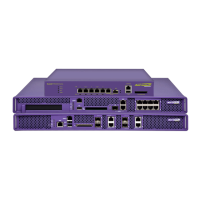Network Setup
Summit WM3000 Series Controller System Reference Guide212
1 Select Network Setup > Adoption Defaults from the main menu tree.
2 Click the WMM tab.
3 Select a radio from the table and click the Edit button.
The AP Type identifies whether the radio is an 802.11a radio or an 802.11 bg radio. This value is read-
only and cannot be modified. There are four editable access categories: Video, Voice, Best Effort and
Background.
4 Enter a number between 0 and 15 for the AIFSN value for the selected radio.
The AIFSN value is the current Arbitrary Inter-frame Space Number. Higher-priority traffic categories
should have lower AIFSNs than lower-priority traffic categories. This causes lower-priority traffic to
wait longer before trying to access the medium.
5 Enter a number between 0 and 65535 for the Tran smit O ps value.
The Transmit Ops value is the maximum duration a device can transmit after obtaining a transmit
opportunity. For Higher-priority traffic categories, this value should be set higher.
6 Enter a value between 0 and 15 for the Contention Window minimum value.
The CW Minimum is combined with the CW Maximum to make the Contention Window. From this
range, a random number is selected for the back off mechanism. Lower values are used for higher
priority traffic.
7 Enter a value between 0 and 15 for the Contention Window maximum value.
The CW Maximum is combined with the CW Minimum to make the Contention Window. From this
range, a random number is selected for the back off mechanism. Lower values are used for higher
priority traffic.
8 Refer to the Status field for the current state of the requests made from applet. This field displays
error messages if something goes wrong in the transaction between the applet and the controller.
9 Click OK to use the changes to the running configuration and close the dialog.
10 Click Cancel to close the dialog without committing updates to the running configuration.
Configuring Access Points
Use the Access Point screen to view device hardware address and software version information for
adopted and unadopted Access Points. For more information, refer to the following Access Point
configuration sections:
● Viewing Adopted Access Points
● Viewing Unadopted Access Points
● Configuring AP Firmware
Viewing Adopted Access Points
Use the Adopted AP tab for gathering device hardware address and software version information for the
Access Point. Use this information to determine whether the Access Point’s version supports the
optimal feature set available for the network.
To view existing adopted Access Point information:

